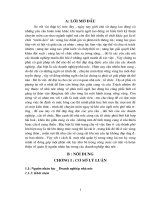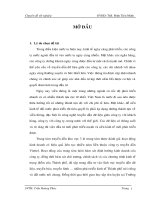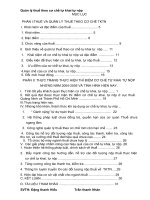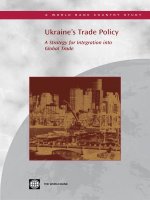Global Trade Operation _ Omgt2321 a3 _ Assignment Three
Bạn đang xem bản rút gọn của tài liệu. Xem và tải ngay bản đầy đủ của tài liệu tại đây (603.65 KB, 28 trang )
Individual Report, 2023
TABLE OF CONTENT
I. INTRODUCTION.................................................................................................................4
II. GLOBAL PERSPECTIVE...............................................................................................4
III. INDUSTRY PERSPECTIVE...........................................................................................5
IV. COUNTRY PERSPECTIVE............................................................................................5
V. CONCLUSION......................................................................................................................5
VI. REFERENCES..................................................................................................................5
1
OMGT2321_GLOBAL TRADE OPERATIONS
Individual Report, 2023
2
OMGT2321_GLOBAL TRADE OPERATIONS
Individual Report, 2023
ABBREVIATION
Household and Personal: H&P
Vietnam Cotton and Spinning Association: VCOSA
Vinh Phuc ICD Logistics Center: VPP
Automatic Container Code Recognition: ACCR
Vehicle License Plate Recognition: ALPR
3
OMGT2321_GLOBAL TRADE OPERATIONS
Individual Report, 2023
Automated Guided Vehicles: AGVs
Artificial Intelligent: AI
Vietnam Logistics Association: ALA
Warehouse Management System: WMS
4
OMGT2321_GLOBAL TRADE OPERATIONS
Individual Report, 2023
EXECUTIVE SUMMARY
In recent years, supply chains have become increasingly complex. In addition, the
operational activity of supply chains was influenced by global changes like the COVID-19
pandemic, the Russia-Ukraine war, and its consequences, as well as significant shifts in
consumer and supplier behavior. These global changes included the dynamic development of
technology and production organization. In this report, the first part “Global Perspective”
presents one of the biggest challenges that the global is facing is supply chain disruption in many
countries and across many industries around the world. The supply chain disruption mainly can
be aggravated by supply chain shortages, including the shortage of raw materials and supply
5
OMGT2321_GLOBAL TRADE OPERATIONS
Individual Report, 2023
delays. The shortage of raw materials lessens the manufacturing of many industries,
causing product supply chain disruption. Besides, the supply delays induce delivery time to
transport raw materials or final products to customers on time in a period of time, which
contributed to a temporary supply chain disruption. Further, port congestion due to lack of
technological support, a worker shortage, Covid-19, and the Russia-Ukraine war, which
prolonged the shipping turnaround and waiting time lengths, caused supply delays that
exacerbated the supply chain disruptions.
The part of “Industry Perspective” displaces the challenge and opportunity the global
disruption presents in the “Household and Personal Products” industry in Vietnam (GICS 3030).
Vietnam's supply chain for both goods and inputs is sensitive and vulnerable in the event of a
disruption in the global supply chain due to the country's heavy reliance on raw materials
imported from foreign suppliers, particularly China and the United States. Due to global supply
disruptions, Vietnam's H&P industry has experienced disruptions in raw material supplies due to
its dependence on importers for inputs. Vietnam's production of H&P products suffers shocks as
a result.
The part of “Country Perspective '' presents the ways technology facilitates exporting and
importing in Vietnam, strengthens the trade freight hub, and overcomes the challenges of high
logistics costs in Vietnam. Their many technologies such as IoT, AI, and WSM are
recommended to apply to help Vietnam's trade and logistics industry enhance their operations,
6
OMGT2321_GLOBAL TRADE OPERATIONS
Individual Report, 2023
facilitate the faster movement of freight, prevent supply delays that have an impact on
manufacturing, increase security, and further restricts human contact to prevent the Covid-19
pandemic from being contagious.
I. INTRODUCTION
This report will be presented in three parts. Part one “Global perspective” analyses an
overview of global supply chain, how supply chain shortages and port congestions contribute to
supply chain disruptions. ‘Industry perspective” part clarifies the challenge and opportunity that
supply chain disruptions presented on H&P industry in Vietnam (GICS 3030). “Country
perspective” mentioned technologies use to facilitate export/import processes, and freight hubs,
and solve high logistics costs challenge.
II. GLOBAL PERSPECTIVE
OVERVIEW
Recently, global supply chains have become increasingly unpredictable, volatile, and
disrupted. Complexly intertwined factors including a shortage of inputs and workers, supply
delays, weak production capacity, logistic bottlenecks, low port efficiency, and extreme
phenomena such as the Covid-19 outbreak and Russian-Ukraine political conflict have
aggravated global supply chain disruption (Grzybowska & Stachowiak 2022).
Many different parts of the world have experienced supply chain disruptions. The global
supply chain of intermediate inputs, semiconductors, electronic components, chips of machines,
7
OMGT2321_GLOBAL TRADE OPERATIONS
Individual Report, 2023
computers, and appliances is seriously disrupted because Asian countries, especially
China, which are the main manufacturers have implemented border control, mobility restrictions,
production scale contraction, or even factory closure to prevent Covid-19 pandemic
consequences (Aboagye et al 2022). Hence, automobile, electronics, and household appliances
supply chains in Asia, Australia, U.S, and Europe are interrupted by the disruption of Asian input
supply chains (Aboagye et al 2022). Africa, North America, Latin America, Asia, and Europe
confronted an unbelievable supply chain disruption of consumer products, textiles, apparel,
aluminum, plastics, construction materials, and notably food (WorldBank 2022). Aside from the
lockdown, UK, and Brexit imposed policies on reducing the number of drivers to increase their
competitiveness, resulting in a severe driver shortage that aggravated supply chain disruptions in
meat, medicine, and household products (Portes 2022). Further, the Russia-Ukraine war
exacerbated food, raw material, and energy supply chain disruption, particularly in Europe (Igan
et al 2022).
1. Supply chain shortage
Supply shortage means the case where the amount of supply of inputs, goods/services
across regions or nations becomes insufficient (Ivanov & Dolgui 2022). The globe was facing
supply chain shortages of raw materials or intermediate inputs. Last two years, shortages in
inputs mainly arose from Corona lockdowns and travel restrictions, labor shortages, and logistics
difficulties that disrupted input supply chains worldwide (Grzybowska & Stachowiak 2022).
8
OMGT2321_GLOBAL TRADE OPERATIONS
Individual Report, 2023
Further, Russia and Ukraine’s export of agricultural commodities, fuel, and gas in the
world account for 10-20% of global exports (OECD 2022). However, Russia-Ukraine political
tension to stop or curtail some raw material exports, resulting in input supply shortages. Input
shortage impaired manufacturing capacity, leading to insufficient products to meet demand,
which exacerbates global supply chain disruptions (Islam et al 2019).
For example, China's pursuit of the "Zero Covid-19" policy which limits exports, caused
shocks to textiles, apparel, household appliances, and electronics industries in Vietnam,
Thailand, and Malaysia which disrupted their supply chains (VNS 2022). Russia-Ukraine war
disrupted palladium, nickel, and neon gas supplies (inputs to produce semiconductor chips),
leading to chip shortages and causing an 11.3 million production unit loss in the global
automobile industry, which worsened the world’s car supply chains (Ebbers 2022).
Besides, supply delay is the failure to make delivery of raw materials or products to their
destination on time, resulting in goods shortages in a certain period (Awaysheh et al 2021). The
COVID-19 pandemic, lockdowns, worker shortages, and global port congestion pressure due to
Russia and Ukraine political tension that slowed port turnaround times, contributed to cargo
shipping delays, prolonged time delivery of raw materials and goods to businesses or customers,
thus, reflecting temporary supply disruptions (Kamali & Wang 2021).
9
OMGT2321_GLOBAL TRADE OPERATIONS
Individual Report, 2023
Figure 1: Supply delivery times in U.S and EU
(Adapted from Port of Seattle 2021)
For instance, U.S. ports have a long averaging around 21 days of wait time for cargo loading and
unloading, U.S. suppliers’ delivery times are considerably longer (Figure 1), implying a supply
delay for importers, disrupting their supply chains (Brown & LaTonja 2021).
2. Port congestions
Port congestion occurs when there are more cargo ships than a port can handle, needed to
dock at a berth to unload or load (Nze & Onyemechi 2018). Port congestion can arise from lack
of digitization, automation, and advanced technology supports that expand loading/unloading
cargo or procedure times (Kia et al 2000). During the Covid-19 pandemic, sick and death cases
increased, further, a large labor force in logistics and port shifted to work in other industries
10
OMGT2321_GLOBAL TRADE OPERATIONS
Individual Report, 2023
causing a temporary worker shortage (Nguyen 2021). Due to lower staffing,
load/unloading activities have slowed, prolonged ship waiting and turnaround times, and caused
port congestion. Russia-Ukraine conflict force both economies lose their ports that pressured
many ports in others, suddenly overloaded their cargo handling capacity, also lead to port
congestion (Jacobs 2022). Therefore, port congestion extended delivery times of shipping,
caused supply delays, and reflected supply chain disruptions in certain periods. Due to Covid-19
pandemic hit, Shanghai port (China) and Los Angeles port (U.S.) faced congestion that had long
turnaround times of 11-12 days, causing semiconductors, food, and oil supply disruption for
Middle Asia and Europe (LaRocco 2022).
III. INDUSTRY PERSPECTIVE
“Household and personal product” industry (GICS 3030)
1. Challenge
Recent upheaval events, eg, global supply chain disruption, Covid-19 pandemic, and the
Russia-Ukraine war which challenged Vietnam’s H&P product industry can be considered a
“change” factor in Porter’s diamond model (Porter 1990).Vietnam relies heavily on raw
materials imported from foreign suppliers, especially China and the United States, therefore, if
the world’s supply chain is interrupted, Vietnam's supply chain for both input and goods is
sensitive and vulnerable (VNS 2022). As Vietnam relies on importers for inputs, its H&P
11
OMGT2321_GLOBAL TRADE OPERATIONS
Individual Report, 2023
industry has faced disruptions in raw material supplies due to global supply disruptions.
As a result, there are shocks in the production of H&P items in Vietnam (VNS 2022).
Vietnam imports 14,276 shipments of chemical pulp to produce toilet or towel paper
from 85 global suppliers, mainly from China and U.S annually (TrendyEconomy 2021). Due to
supply chain disruption, high demand as toilet papers and towel papers are necessities in Covid-
19 pandemic that forces many suppliers to stop or limit chemical pulp exports, stockpiling for
their domestic use (OECD n.d). Policies of restrictions or bans on raw material export can be
viewed as trade barriers to Vietnam’s toilet paper production.
Some Vietnam H&P enterprises (Green Cross or F5B) are outsourcing partners of
Thailand and Korean cosmetic brands. Due to disruptions in the supply chain, Vietnam lacks raw
materials for cosmetics, toilet paper, tissue, and shampoo, forcing foreign businesses to shift to
in-house production or seek other outsourcing options (Santarek 2022). This decreased
production values and competitiveness in Vietnam's H&P industry.
Further, Vietnam continues to be a net importer of cotton, with a domestic supply
estimated to be less than 5% of total market demand (Vo 2021). 55% of cotton is imported from
China (Pham 2022, Figure 2). China's pursuit of a "zero-Covid" approach that dramatically
reduced cotton exports to Vietnam, caused significant shocks to domestic production of diapers,
cotton pads, and swabs. This depreciates the efficiency of Vietnam's cotton global sourcing
which forces Vietnam to discover other global sourcing alternatives such as Brazil, or India (Vo
12
OMGT2321_GLOBAL TRADE OPERATIONS
Individual Report, 2023
2021, Figure 3). However, according to VCOSA, cotton import prices from India and
Brazil both increased by 0.87%, higher logistic costs, compared to sourcing in China (Pham
2022). This increased production costs and H&P item prices in Vietnam. Global supply chain
disruption loses Vietnam's global sourcing process efficiency, challenging Vietnam H&P
production.
Figure 2: Vietnam’s Yarn Imports from Worldwide Markets (TMT) (Adapted from Pham 2022)
13
OMGT2321_GLOBAL TRADE OPERATIONS
Individual Report, 2023
Figure 3: Cotton import of Vietnam by TMT (Adapted from Vo 2021)
2. Opportunity
Global supply chain disruption creates opportunity for the H&P industry in Vietnam. The
information about foreign supply chain disruption, and factory closures, shelter-in-place in
response to the coronavirus pandemic, encourages the psychology nervousness and panic-buying
of Vietnam consumers toward necessities (toilet paper, tissue, soap, or hand sanitizers), which
dramatically push domestic demand (Nguyen 2021). Regarding Figure 4, Vietnam's domestic
consumption of H&P items increased to 40.18%, placing it in the top 3 products with the highest
domestic demand in 2020 (Nguyen 2021). Thereby, domestic production of H&P products is
focused to be seriously promoted, increasing Vietnam’s H&P industry competitiveness. Further,
supply disruption support Vietnam's H&P products do not need to compete with foreign
products. Generally, the Vietnam H&P industry achieved the remarkably surging domestic
14
OMGT2321_GLOBAL TRADE OPERATIONS
Individual Report, 2023
demand for toilet paper, toilet paper, diapers, hand soap, and hand sanitizer. Based on
the “Demand condition” factor implication in Porter’s diamond (Porter 1990), heightened
domestic demand for H&P items implies an opportunity for Vietnam’s H&P domestic industry
and a competitive advantage for Vietnam in manufacturing H&P products against other foreign
suppliers amid global supply chain disruption.
Figure 4: Main products that were purchased more often online during coronavirus
(COVID-19) in Vietnam 2020 (Adapted from Statista 2021)
Besides, Vietnamese government conducts ‘self-sufficient’ manner, encourages supports
from other industries such as agricultural, wood, or chemical industries to supply domestic raw
material for H&P production (Luong 2020). Based on Porter's diamond ‘Related and supportive
industries’ factor (Porter 1990), the Vietnam H&P industry gains other industries' support for
domestic raw material supply, which is considered more successful and competitive than others.
15
OMGT2321_GLOBAL TRADE OPERATIONS
Individual Report, 2023
Further, supply chain disruptions strengthened Vietnam’ domestic H&P companies’
production and management capacity.
IV. COUNTRY PERSPECTIVE
1. Facilitating exporting/importing process
Vietnam's export/import processes are challenged by many manually complex paper
procedures, long-time processes, inconsistency in collecting and managing information from
various stakeholders, shortcomings in monitoring the correct number of goods, and lack of safety
in stock (Nguyen 2021).
Internet of Things (IoT) can be an ideal solution to facilitate Vietnam’s export/import
processes. IoT is a system of connected digital, mechanical, and computing devices that can
summary and transfer data without human interaction (Madakam et al 2015). IoT helps
exporters/importers connect and share information with different stakeholders, benefits customs
authorities to increase the variety of data, improved risk management, greater the customs
clearance process, and better analytics (Figure 5). IoT tracks the integrity of transshipment cargo
movement between entry and exit control points, standardizes procedures for traders' benefit,
speeding up the loading and unloading of cargo in port regions, connects potential creative
solutions, and streamlines manual operations to increase (Kumar & Dash 2017). For example,
QR Codes for transit and barcode readers; automated license plate readers; RFID antennas to
monitor freight delivery times, e-seals to ensure traceability of goods and means of transport,
16
OMGT2321_GLOBAL TRADE OPERATIONS
Individual Report, 2023
usage of e-lock, GPS tracking, X-ray scanners, and CCTVs interconnected with customs
to automatize border crossing procedures, guarantee security at ports (Varese et al 2021). As a
result, IoT helps the faster movement of freight, avoiding supply delays affecting manufacturing,
more security, further, limiting human contact that can avoid the Covid-19 pandemic contagious.
Figure 5: Benefit of IoT (Adapted from WTO n.d)
2. Strengthening freight hubs
Vietnam has applied IoT and AI to facilitate seaport operation efficiency to reduce
procedure times and port management inconsistency (Nguyen 2021).
17
OMGT2321_GLOBAL TRADE OPERATIONS
Individual Report, 2023
Vietnam strengthens port operational efficiency, for instance, VPP by applying
IoT such as using robots to automate warehouses with the computer control system;
automatically monitor the information and schedule of containers entering and exiting ports,
which are transmitted to the control center through existing information networks (Nguyen
2021). Moreover, VPP applied AI on the Edge technology, AGVs improve ports’ warehouse
efficiency, AI Machine learning helps the port automate its manual producers, reduce the paper-
documentation pressure, reduce errors in exporting/importing process, and save times that
enhance the efficiency and speed of cargo transportation (Nguyen 2021). AI cameras with
ACCR, ALPR, and driver-face recognition systems, support Vietnam’s seaports to ensure port
security (Tsolakis et al 2021). Those technology upgrades port management and eases customer
procedures, which facilitates the export-import of freight.
Additionally, Vietnam implements installed an automatic gate at its center seaports, such
as Da Nang port, utilizing an AI-powered ACCR algorithm to identify the container code,
identify the tractor/trailer license plate numbers, control the barrier's opening and closing with a
PLC, reading the electronic weighing terminal's indicator, using a Robot (RPA) to carry out
commands, sending information through the driver's smartphone app, reduce delivery times and
save money on printing with all digitized documents (Lan 2022). Regarding the smart gate, every
document-handling sector is considerably more convenient with the utilization of Internet-
connected devices. The ePORT software saves waiting times, lowers customer costs, improves
18
OMGT2321_GLOBAL TRADE OPERATIONS
Individual Report, 2023
objectivity, guarantees information transparency, and lessens handling paperwork errors
(APEC 2014). Consequently, the port management capacity and efficiency are strengthened by
advanced technologies.
3. Logistics Challenge: High logistics costs
Vietnam's logistics industry is facing high logistics costs. Regarding Worldbank (2020),
Vietnam’s logistics costs are about 20.9-25% of GDP, much higher than China (18%) and nearly
three times higher than the US (7.7%) and Singapore (8%) (Nguyen 2021). High logistics costs
arise from ICT investment absence at first. Vietnam logistic enterprises lack capital, experience,
and proficient management capacity. Further, Russia-Ukraine war also increases Vietnam's
export/import costs, reducing its competitive advantage over Asian countries (Jacobs & Soone
2022)
Therefore, Vietnam applies IoT and WMS to lower transportation and warehousing costs
to reduce logistics costs. Through integrated diagnostics and sensors, trucks or vessels can be
transformed into data-transmitting vehicles, allowing IoT systems to track their routes (Song et al
2021). Thus, IoT can map the shortest and most fuel-efficient vehicle routes, lowering
transportation costs. IoT permits data from data capture devices installed on vehicles sent
directly to a web-based software platform for fleet management software tracking(Barcelo et al
2016). Hence, better truck or ship coordination can help to save fuel costs, reduce transportation
expenses. WMS automates the process of order fulfillment from sourcing raw materials to
19
OMGT2321_GLOBAL TRADE OPERATIONS
Individual Report, 2023
shipping finished goods. WMS handled all routine tasks such as picking-and-placing
items, scanning barcodes and RFID tags, and immediately updating inventory records in the ERP
system, optimized warehouse operation, reduced incurred costs (Ramaa et al 2012). Overall, IoT
combined WMS can be considered a method to reduce logistics costs in Vietnam.
V. CONCLUSION
In short, from the “Global perspective”, the global supply chain is seriously disrupted due to a
shortage of raw materials and intermediate inputs and supply delays. Further, the port
congestions contribute to exacerbating supply chain disruption. As far as the "Industry
perspective" is concerned, Vietnam's H&P industry has suffered from raw material shortages due
to disruptions in supply chains. Finally, “Country perspective” presented IoT, AI, and WMS,
combined power tools to facilitate export/import processes, and freight hubs, and overcome high
logistics costs.
VI. REFERENCES
Aboagye A, Burkacky O, Mahindroo A and Wiseman B (2022) When the chips are down: How
the semiconductor industry is dealing with a worldwide shortage, World Economic Forum
website, accessed 12 January 2023. />chip-shortage-supply-chain/
20
OMGT2321_GLOBAL TRADE OPERATIONS









